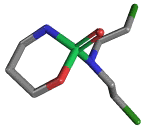|
CYCLOPHOSPHAMIDE |
| Synonyms. Cyclophosphamide; Ciclophosphamide; Cyclophosphamidum; Cyklofosfamid; (RS)-Cyclophosphamide; Ciclofosfamida; 1-Bis(2-chloroethyl)amino-1-oxo-2-aza- 5-oxaphosphoridin; 2-(Bis(2-chloroethyl) amino)-2H-1,3,2-oxazaphosphorine 2-oxide; 2-(Bis(2-chloroethyl) amino) tetrahydro -2H- 1,3,2-oxazophosphorine 2-oxide; Endoxanal; 4-Hydroxy- cyclophosphan- mamo phosphatide; Bis(2-chloroethyl)phosphoramide cyclic propanolamide ester; Genoxal; N,N-Bis(2-chloroethyl)-N',O-propylenephosphoric acid ester diamide; N,N-Bis(beta-chloroethyl)-N',O- trimethylenephosphoric acid ester diamide; Zyklophosphamid; |
|
|
| PRODUCT IDENTIFICATION | |
|
CAS RN |
50-18-0 (anhydrous), 6055-19-2 (monohydrate) |
|
EINECS RN |
200-015-4 |
|
FORMULA |
C7H15Cl2N2O2P |
|
MOLE WEIGHT |
261.09 |
|
H.S CODE |
2934.99.9000 |
|
SMILES |
N([P@@]1(NCCCO1)=O)(CCCl)CCCl |
|
CLASSIFICATION |
Imidazotetrazine alkylating agent, Antineoplastic agent,Defleecing agent |
|
EXTRA NOTES |
Precursor of an alkylating nitrogen mustard antineoplastic and immunosuppressive agent that must be activated in the liver to form the active aldophosphamide. It has been used in the treatment of lymphoma and leukemia. Its side effect, alopecia, has been used for defleecing sheep. Cyclophosphamide may also cause sterility, birth defects, mutations, and cancer
(Mesh). Overall Carcinogenic Evaluation: Group 1 Other RN: 60007-95-6, 75526-90-8 |
|
|
| PHYSICAL AND CHEMICAL PROPERTIES | |
|
PHYSICAL STATE. |
white to off-white crystalline powder |
|
MELTING POINT |
51 ~ 52 C |
|
BOILING POINT |
|
|
DENSITY |
|
|
SOLUBILITY IN WATER |
40 g/l |
| SOLVENT SOLUBILITY | Sparingly soluble in ether and acetone. Soluble in alcohol, benzene, ethylene glycol, chloroform, dioxane. |
|
VAPOR DENSITY |
|
|
log P(octanol-water) |
0.63 |
|
VAPOR PRESSURE |
|
|
AUTOIGNITION TEMP |
|
| pK |
15.29 |
|
REFRACTIVE INDEX |
|
|
FLASH POINT |
|
|
|
| STABILITY AND REACTIVITY | |
| STABILITY | Stable under normal conditions. |
|
INCOMPATIBLE MATERIALS |
Strong oxidizing agents. |
| POLYMERIZATION |
Has not been reported |
|
NFPA RATINGS |
Health: 2, Flammability: 0, Reactivity: 0 |
|
|
| EXTERNAL LINKS & GENERAL DESCRIPTION |
|
Wikipedia Linking - Cyclophosphamide Google Scholar Search - Cyclophosphamide Drug Information Portal (U.S. National Library of Medicine) - Cyclophosphamide PubChem Compound Summary - Cyclophosphamide Drug Bank - Cyclophosphamide KEGG (Kyoto Encyclopedia of Genes and Genomes) - Cyclophosphamide http://www.ebi.ac.uk/ - Cyclophosphamide http://www.ncbi.nlm.nih.gov/ - Cyclophosphamide http://toxnet.nlm.nih.gov/ http://www.vcu.edu/ |
|
|
| SALES SPECIFICATION | |
|
APPEARANCE |
white to off-white crystalline powder |
|
ASSAY |
98.5% min |
|
MELTING POINT |
51 ~ 52 C |
| IMPURITY |
1.0% max (total), 0.5% max (individual) |
|
LOSS ON DRYING |
1.0% max |
|
HEAVY METALS |
20ppm max |
| RESIDUE ON IGNITION |
0.1% max |
|
|
| TRANSPORT & REGULATORY INFORMATION | |
|
UN NO. |
3464 |
| HAZARD CLASS |
6.1 |
| PACKING GROUP | III |
|
|
| SAFETY INFORMATION |
|
|
HAZARD OVERVIEW |
May cause respiratory irritation. May cause genetic defects. Toxic if swallowed. Causes serious eye irritation. May cause cancer. Causes skin irritation. May damage the unborn child |
|
GHS |
|
|
SIGNAL WORD |
Danger |
|
PICTOGRAMS |
|
|
HAZARD STATEMENTS |
H335-H340-H301-H319-H350-H315-H360D |
|
P STATEMENTS |
P301 + P310-P201-P308 + P313-P261-P302+ P352-P280-P305 + P351 + P338 |
| EC DIRECTIVES |
|
| HAZARD CODES |
|
|
RISK PHRASES |
45-46-61-25-36/37/38 |
|
SAFETY PHRASES |
53-26-37/39-45 |
|
|
| PACKING |
|
Preserve in light-resistant and well-closed containers |


